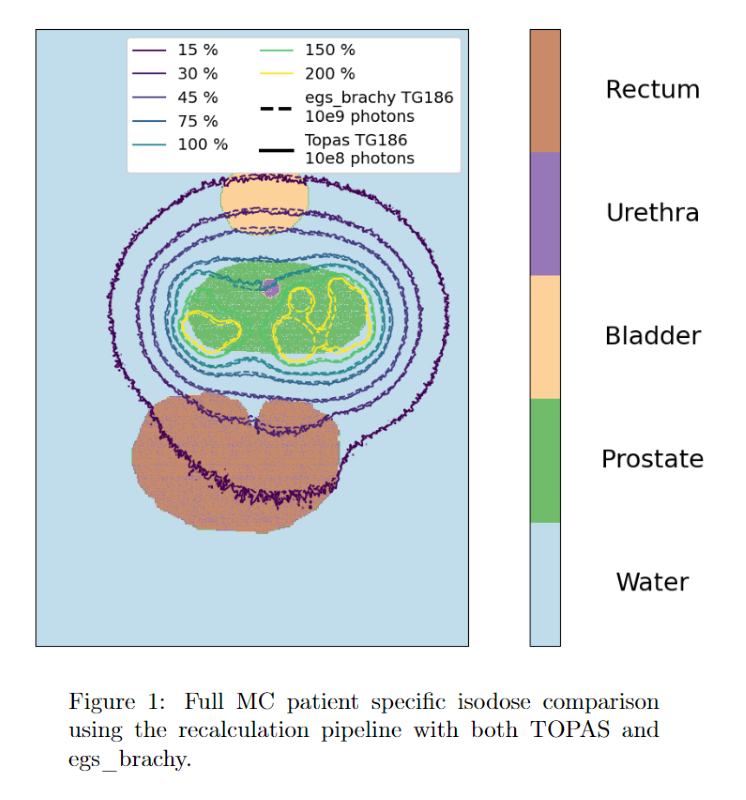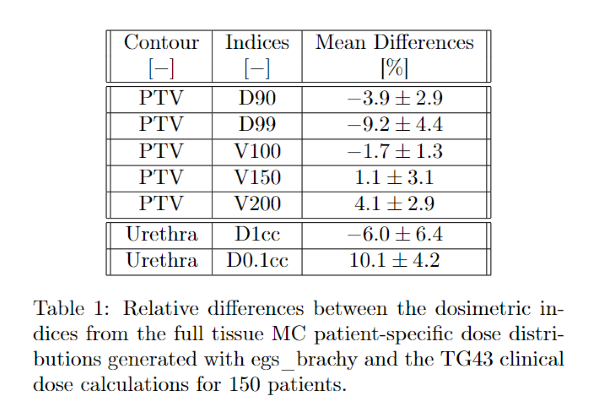Systematic MC dose recalculation pipeline: a use case in permanent implant prostate brachytherapy
PO-2169
Abstract
Systematic MC dose recalculation pipeline: a use case in permanent implant prostate brachytherapy
Authors: Samuel Ouellet1, Yannick Lemaréchal2, Francisco Berumen1, Éric Vigneault2, André-Guy Martin2, William Foster2, Marie-Claude Lavallée2, Rowan Thomson3, Philippe Després4, Luc Beaulieu4
1Université Laval, Département de physique, de génie physique et d'optique, Québec, Canada; 2CHU de Québec - Université Laval, Département de radio-oncologie et Axe Oncologie du CRCHU de Québec, Québec, Canada; 3Carleton University, Carleton Laboratory for Radiotherapy Physics, Department of Physics, Ottawa, Canada; 4Université Laval, Département de physique, de génie physique et d’optique, Québec, Canada
Show Affiliations
Hide Affiliations
Purpose or Objective
MC simulations are the golden standard when it comes to dosimetry. Although they are not close to being used in treatment plan optimization, they provide realistic references for patient specific dosimetry. Such references are key components to quantify the accuracy of clinically used TPS and to study the relationship of dose-tissue responses. A MC dose recalculation applied to all delivered treatments would provide the statistically significant sample needed for these studies. The goal of this work is to build a fully automated systematic MC dose recalculation pipeline applied to permanent implant prostate brachytherapy.
Material and Methods
Starting from the entire DICOM RT set, the pipeline reproduces the treatment context within the MC simulation. The sources’ model, positions and strength are extracted from the RTPLAN while the geometry of the patient is built based on the clinical contours stored in the RTSTRUCT and on prostate calcifications segmentation, when present. The dose scoring can use both CT or clinically used dose grid resolutions. To benchmark the pipeline for permanent implant brachytherapy using the Nucletron SelectSeed, TG43-like MC simulations (infinite homogeneous water medium) are validated against standard TG43 calculations for a single seed and a full treatment plan with both TOPAS and egs_brachy MC codes. For full MC patient specific dose distributions, the validation is made by comparing the simulation results of both MC codes. Finally, the MC dose recalculation is applied to a real use case, caracterising the weaknesses of the TG43 calculations. To do so, a dosimetric comparison is made between the full MC and the clinical dose distributions for 1500 patients.
Results
When comparing the TG43-like simulations to the TG43 calculations for 10e9 photons, the %∆Dlocal values for egs_brachy are within ±2.5% and ±7.5% for the single seed and the full plan, while TOPAS’s values are within ±2% and ±3%. Being a voxel-per-voxel analysis, it shows an excellent agreement between the generated MC simulations and the TG43 calculations. When comparing the full MC patient specific dose distributions using TOPAS and egs_brachy, figure 1 show a good agreement between the isodose lines. The preliminary results on the first 150 (10%) patients without prostate calcifications for the dosimetric comparison between the MC simulations and the TG43 calculations are shown in table 1. The mean differences found in the dosimetric indices are consistent with published results given the neglected interseed attenuation and the point source approximation used in clinical dose calculations.

Conclusion
In this work, a validated systematic MC dose recalculation pipeline for permanent implant brachytherapy is built and launched on a large-scale patient cohort. Based on the produced patient specific dose distributions, the weaknesses of the TG43 calculation are characterized for real patient treatments. This dose dataset could be used in future work to study the dose-tissue response relationships.